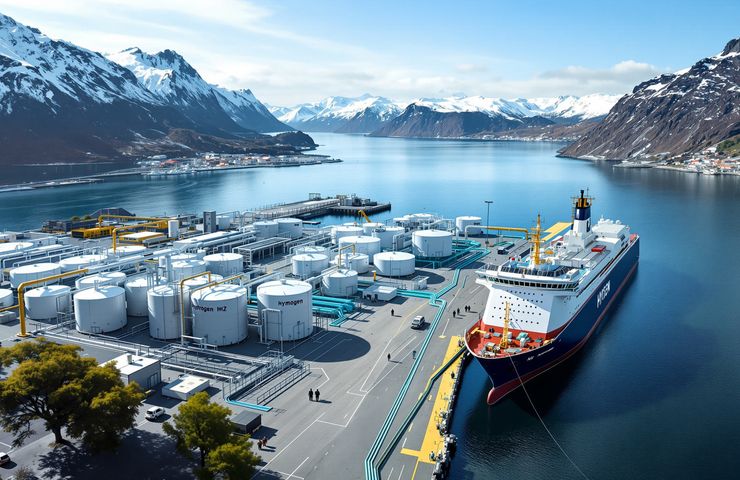
GreenH’s FID greenlights two Norwegian electrolysis plants
November 12, 2025It’s not every day you see a brand-new hydrogen value chain spring up—but on November 10, 2025, GreenH made it happen. The Norwegian developer just gave the green light on final investment decisions for two green hydrogen plants that promise to shake up how ships and local industry get their zero-emission fuel. Backed by the government, the sites at Vestbase in Kristiansund and Slagentangen outside Tønsberg will tap into Norway’s bounty of renewable electricity, targeting hard-to-abate maritime transport and nearby industrial hubs. Each plant boasts over 20 MW of electrolysis capacity, powered in part by Enova’s NOK 391 million grant. This move follows the earlier FID at Bodø—which snagged NOK 129 million—underscoring a coast-to-coast strategy for hydrogen hubs.
From plan to final investment
After months of front-end engineering design studies, environmental assessments, and jumping through grid-connection hoops, these projects have finally locked in. With FIDs in place, GreenH can secure equipment orders—think advanced alkaline electrolyzers from Nel ASA—and hedge against raw-material and shipping price swings. It’s a lesson learned from past renewable rollouts, where delays drove up costs. More importantly, it sends a clear signal: hydrogen production is ready to compete with fossil-based alternatives, right as Europe tightens the IMO’s Energy Efficiency Existing Ship Index and rolls out its Fit for 55 package.
Regional maritime hubs
Kristiansund—home to about 25,000 people on Norway’s rugged west coast—hosts Vestbase, one of the country’s busiest offshore service ports. Its deepwater docks and heavy-lift cranes, long used for oil and gas, are a perfect fit for unloading hydrogen equipment. On the eastern shore of the Oslofjord, Slagentangen in Tønsberg sits right next to industrial clusters and busy ferry routes. Both ports have shipping and shipbuilding in their DNA, so moving to zero-emission fuel feels like second nature. Local officials are already celebrating the promise of new green jobs and keeping their ports front and center in a decarbonizing world.
Powering bunkers with electrolysis
At the heart of each site is the electrolysis process: renewable electricity splits water into hydrogen and oxygen in a closed, emission-free loop. With Norway’s abundant hydropower, the carbon intensity of this green hydrogen is practically zero. The multi-MW electrolyzer arrays will run at pressures up to 30 bar, churning out high-purity hydrogen ready for compression and use. By scaling beyond pilot projects to 20 MW-plus, GreenH is banking on improved efficiency curves and lower unit costs. These installations will act as live testbeds, fine-tuning operating protocols and feeding data back into the design of future plants.
Seamless hydrogen bunkering
Producing hydrogen is only half the battle—getting it safely into vessels is the other. That’s where hydrogen bunkering comes in. At Vestbase, GreenH is teaming up with NorSea, tapping the logistics operator’s decades of offshore-supply know-how. They’re retrofitting infrastructure with high-pressure compressors and insulated transfer hoses so ships can top off hydrogen tanks almost the same way they do with conventional bunker fuels. Over at Slagentangen, a partnership with Grieg New Energy means local industries and ferries get direct pipeline connections and storage—skipping the headaches of liquid carriers and making refueling a breeze.
Charting Norway’s green shipping future
These two FIDs aren’t just checkboxes—they answer the long-standing question: “Will there ever be enough green fuel to power Norway’s coastal fleet?” With concrete commitments in Kristiansund and Slagentangen, ship operators can start planning retrofits or newbuilds around a dependable supply. Add in upcoming carbon pricing and stricter emission caps, and the tide is unmistakably turning toward zero-emission tech like fuel-cell propulsion and even ammonia-based fuels.
Wider ripple effects
The benefits spread far beyond ports and ships. Building and running these plants will upskill a new generation—from electrical technicians to hydrogen-safety specialists. Local universities and training centers are already lining up to offer specialized courses. The power grid will see fresh demand patterns, spurring investments in storage batteries and smart-grid controls. Economically, demonstrating successful industrial decarbonization through operational hydrogen hubs bolsters Norway’s reputation as a tech and know-how exporter. Environmentally, these projects are on track to cut hundreds of thousands of tonnes of CO₂ over their lifetimes, supporting both national and EU decarbonization targets.
What’s on the horizon?
Construction at both sites kicks off in early 2026, with first hydrogen deliveries expected by mid-2027. Next up: keeping an eye on the Bodø facility and scoping out expansions to other ports like Bergen or Kristiansand. GreenH plans to publish performance data publicly, helping regulators fine-tune the rules and attracting more private capital. If everything hits its marks, this could spark a wave of hydrogen production rollouts along Europe’s coastlines, building a robust network of zero-emission bunkering points.
About GreenH
GreenH is a Norwegian development and operations company focused on green hydrogen production projects that decarbonize maritime transport and local industry. Headquartered in Norway and led by CEO Morten Solberg Watle, GreenH has solid backing from Enova and collaborates with partners like Nel ASA, NorSea, and Grieg New Energy. Together, they’re building Norway’s first fully functional hydrogen value chain with plants in Bodø, Kristiansund, and Slagentangen.


 With over 15 years of reporting hydrogen news, we are your premier source for the latest updates and insights in hydrogen and renewable energy.
With over 15 years of reporting hydrogen news, we are your premier source for the latest updates and insights in hydrogen and renewable energy.